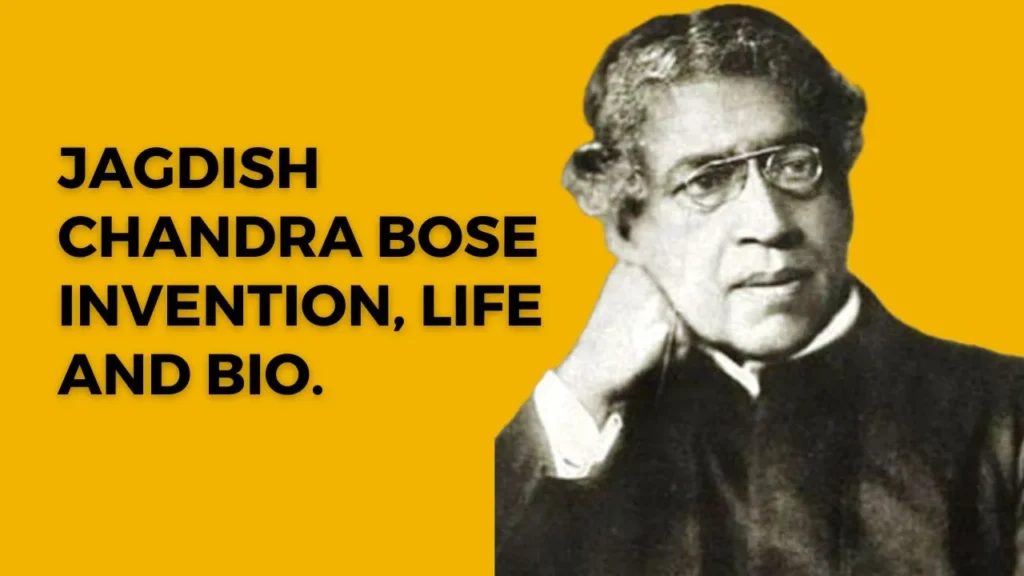Introduction: Jagdish Chandra Bose Invention and Life Snippets.
Sir Jagdish Chandra Bose was a renowned polymath of his time. He had a keen interest biology, physics, botany and science fiction. Known for his work on radio microwave optics, he was the man responsible for expansion of experimental science in Colonial India. This blog post takes a look at Jagdish Chandra Bose invention, his life and other aspects which influenced him.

Description:
Let us delve into the extraordinary life and contributions of Jagdish Chandra Bose. A trailblazing scientist whose work revolutionized the fields of physics and biology. Let us explore the journey of a man whose scientific curiosity knew no bounds.
FAQs about Jagdish Chandra Bose:
When and where was he born?
He was born on November 30th, 1858, in Mymensingh, British India (present-day Bangladesh).
Who were his parents?
His father’s name was Bhagawan Chandra Bose and his mother was Bana Sundari Bose.
What were his father’s occupations?
Bhagawan Chandra Bose was a civil servant who held a position in the British colonial administration.
Did he have siblings?
Jagdish Chandra Bose had two other siblings.
Can you provide details about his wife?
He married Abala Bose; he dedicated his life entirely to scientific pursuits.
Where did he receive his early education?
He began his early education in his hometown Mymensingh and later moved to Kolkata. He studied at the Hare School and then at the St.Xaviers School.
What were his educational qualifications?
He completed his Bachelor’s degree at the University of Calcutta. Later, he pursued studies in natural sciences at the University of Cambridge, England.
Did he work in academia?
He worked as a professor of physics at the Presidency College in Calcutta (now Kolkata), British India.
How did he fund his scientific research?
He faced financial challenges and often used personal funds to finance his research. He believed in self-reliance for his scientific pursuits.
What was his early life like?
He grew up with a keen interest in nature and science. He showed signs of curiosity and experimentation from a young age.
Jagdish Chandra Bose Invention, Scientific Beliefs and Impact.
How did he develop a love for science?
His love for science was cultivated through his upbringing. He spent a lot of time exploring the natural world and conducting experiments.
What is his most famous invention?
His most famous invention is the crescograph. It is a device that measures plant growth and responses to various stimuli.
How did the crescograph work?
The crescograph recorded the movements and growth patterns of plants. It unveiled their responses to light, heat, and other external factors.
How did Jagdish Chandra Bose invention impact the world?
Jagdish Chandra Bose invention revolutionized the understanding of plant physiology. It laid the foundation for advancements in agriculture and biology.
How did this invention contribute to scientific knowledge?
The crescograph provided invaluable insights into the behaviour of plants. It went on to prove that plants exhibit life-like responses to their environment.
Did he have any patents for his inventions?
He did not patent many of his inventions. He believed in the free exchange of scientific knowledge for the benefit of humanity.
How did his work contribute to the development of wireless communication?
His experiments with microwaves and radio waves laid the groundwork for the development of wireless communication technology.
How did Bose’s inventions challenge contemporary scientific beliefs?
His research challenged prevailing scientific notions, particularly his demonstration that plants have life and respond to stimuli.
Did he face challenges in getting his work recognized?
He faced challenges and skepticism from some sections in gaining recognition for his work, especially in the British scientific community.
Awards, Work on Biophysics and Collaborations.
How did his relationship with British rulers influence his work?
His relationship with British rulers was complex. While he received support from some, he also encountered colonial attitudes that hindered recognition.
Did he receive awards for his scientific contributions?
He received numerous awards including the Companion of the Order of the Indian Empire (CIE). He was also conferred with Knighthood for his scientific achievements.
Did he contribute to the field of biophysics?
He made significant contributions to biophysics, majorly in understanding electrical responses of plants and their cellular processes.
How did his research impact agriculture?
His research provided major insights into plant growth patterns and responses, aiding in crop management.
Did he engage in philanthropy?
While he focused on scientific pursuits, he also supported social causes. He contributed to educational and cultural initiatives.
Did he have any collaboration with other scientists?
He collaborated with renowned scientists like Marconi and Einstein, showcasing the global impact of his work.
Were his contributions acknowledged during his lifetime?
Bose received recognition during his lifetime. Some of his groundbreaking work gained more widespread acknowledgment posthumously.
How did his research on microwaves influence technology?
His research on microwaves laid the foundation for the development of technologies like radar and microwave communication.
Engaging With Aspiring Scientists and Legacy.
Did he actively engage with students and aspiring scientists?
He was a dedicated teacher who actively engaged with students, inspiring them to pursue scientific inquiry.
How did his work impact the understanding of the nervous system?
His experiments on plant responses contributed to the understanding of nerve impulses and responses in both plants and animals.
How did his work influence subsequent generations of scientists?
His work laid the foundation for future scientific research. It inspired generations of scientists to explore the realms of physics and biology.
Did his experiments have ethical considerations?
His experiments on plants were conducted with ethical considerations. He ensured minimal harm and advancement in the understanding of plant life.
How did he contribute to the global scientific community?
His collaborations and contributions reached the global scientific community. It fostered international recognition of Indian scientific prowess.
Did he publish his research findings?
He published his research findings in scientific journals, sharing his discoveries with the broader scientific community.
What is his lasting legacy in the scientific community?
His legacy is marked by his groundbreaking contributions to physics, biology, and technology, inspiring generations of scientists.
Conclusion:
Jagdish Chandra Bose invention and contribution to science have left a lasting impression on our understanding of the natural world. His pioneering spirit and innovative research continue to inspire students of science. His work emphasizes the power of curiosity and the pursuit of knowledge. With his heartwarming story, we celebrate this visionary whose work shaped the landscape of scientific exploration. Dear readers, you may read some of our other blogs from the “Home” page of our website. Our blogs are available in over 20 different languages.

